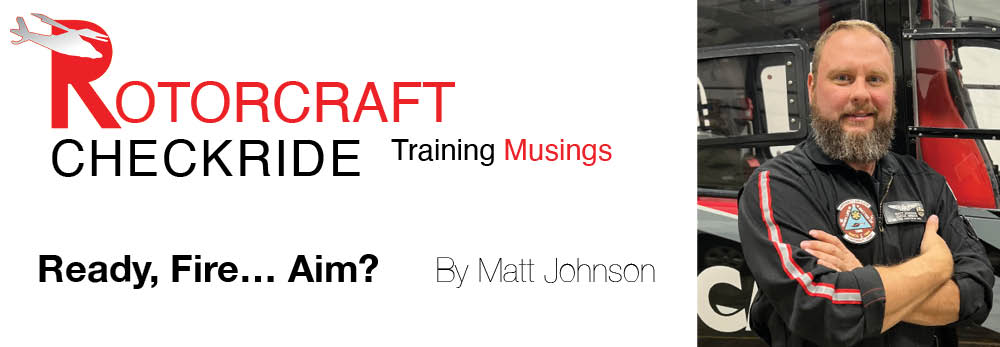|
Oct
25
2024
|
|
Posted 1 years 58 days ago ago by Admin
|
|

It's not exactly the ideal order, and it may sound a bit comical, considering we know the correct order if we want any level of success in hitting our "target." But sadly, all of us have fallen prey to getting ahead of ourselves, leaving out essential details and failing to "aim" on the critical information when we need it to count the most, like taking aim and accomplishing something crucial like successfully passing a practical exam.
The day of your practical test shouldn't be one with a misaligned mindset. You can (and should) be competently prepared, and by doing so, you can certainly combat any disorganized hip-shooting without aim.
I have seen it numerous times in my tenure as a DPE. Those applicants who achieve success have an appropriately aligned mindset. Their mindset is one of ready, aim and follow through (or fire) mindset. Conversely, those who come to the practical exam with bits and pieces of information with the hopes they can assemble the giant puzzle well enough to succeed often struggle. While I can't provide an exhaustive list in my allotted column space, I can reflect on a common theme that may help you align your approach so that you may take an accurate aim before firing off a disorganized or inaccurate response to your evaluator on practical test day.
It should come as no surprise that electronic flight bags (EFBs) are a commonality in all sectors of aviation these days. I saw the gradual shift from all-paper to all-electronic over the past decade-plus. The FAA has recognized the importance of EFBs as well, as evidenced by their mention in the newly (May 2024) released Airman Certification Standards (ACS). In the Private Pilot ACS under “Appendix 3: Aircraft, Equipment, and Operational Requirements & Limitations,” you will find the following verbiage:
"If the applicant has trained using a portable electronic flight bag (EFB) to display charts and data and wishes to use the EFB during the practical test, the applicant is expected to demonstrate appropriate knowledge, risk management, and skill appropriate to its use."
This is one of the areas where applicants are often misaligned with their knowledge. They know how to make a magenta line show up for their cross-country, but they frequently lack the skill set beyond that. What does that magenta line show? A true course or a magnetic course? What is the difference? Do you know how to create and insert checkpoints for your cross-country? What if you see something on the sectional chart, such as a symbol you just don't recognize or have forgotten its meaning? Where do you go to find the answer? In the days of "paper," it was easy to find the legend on a sectional chart, but do you know how to readily and rapidly find the sectional legend in your favorite heavy-hitter flight planning app? I've seen numerous applicants struggle with this over the years, often resulting in less-than-desirable results on a practical test.
Another frequent area where applicants need better aim is related to performance planning. Once again, apps have created an environment where applicants find an answer without really knowing the "how" or "why" of a given app-derived solution. (Please, don't think I am anti-app; I emphatically promote their use.) You just need to know "how the sausage is made," as they say. You need to understand how the answers and solutions are derived. In the case of performance planning, I recently had an applicant present a weight-and-balance that looked great on the surface. However, when compared to the actual weight and balance data from the specific flight manual for the particular aircraft to be used, the numbers didn't match. The applicant had simply inserted his and my weight into the spreadsheet and hit "enter." Although the fill-in-the-blanks spreadsheet was for the same make and model, it was for a different aircraft with a substantially different aircraft empty-weight. When queried, the applicant didn't know how to change the W&B application aircraft-weight fields (locked), nor did they know how to calculate a new W&B via the tried and true pencil-to-paper method. In another recent performance related snafu during a commercial exam, an applicant failed to work the lateral CG for the model of aircraft we were testing in. She worked a longitudinal CG because that was all she was familiar with, as the aircraft utilized for her private pilot training had only longitudinal CG limits published.
This broken record could continue for things like the calculation for in and out of ground-effect hover performance where mere raw numbers are simply punched into an app, but I think you get the point by now. For students and instructors alike, it is imperative that you take a more aimed approach and avoid hip-shooting by fully understanding how results are derived.
READ MORE ROTOR PRO: https://justhelicopters.com/Magazine
WATCH ROTOR PRO YOUTUBE CHANNEL: https://buff.ly/3Md0T3y
You can also find us on
Instagram - https://www.instagram.com/rotorpro1
Facebook - https://www.facebook.com/rotorpro1
Twitter - https://twitter.com/justhelicopters
LinkedIn - https://www.linkedin.com/company/rotorpro1